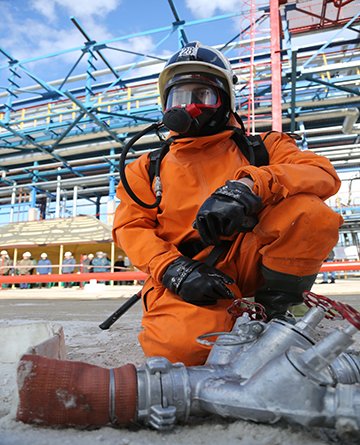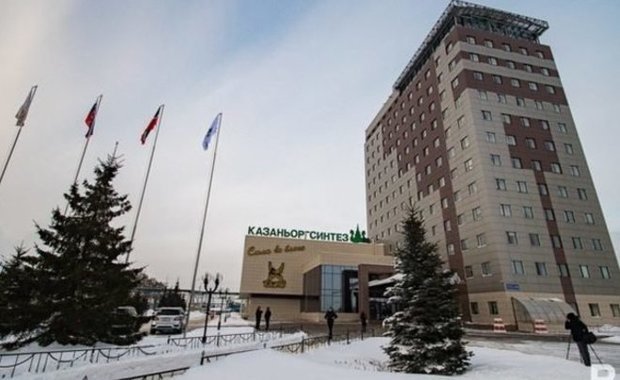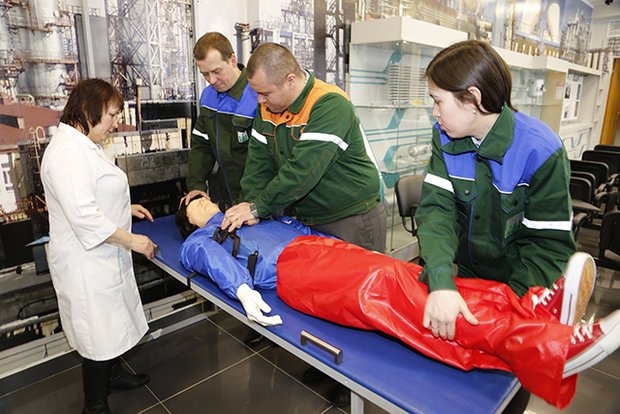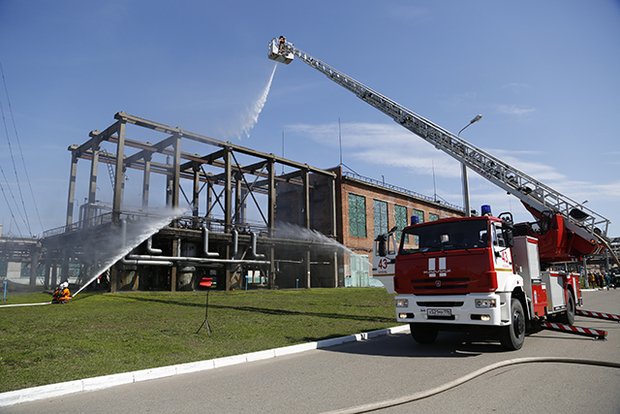Grigory Shrom: ''Industrial safety means safety of both the enterprise’s workers and citizens – it’s the essence of Kazanorgsintez’s policy''
Deputy head engineer on unprecedented safety measures and this February’s accident
Hazardous industrial facilities, which are located inside the city limits, receive the increased attention of the population. Any accidents occurring in the facility cause a great public outcry. The response that arose after publishing photos of the accident on the industrial site of Kazanorgsintez this February in social networks can prove it. Meanwhile, deputy head engineer on industrial safety at Kazanorgsintez PJSC Grigory Shrom told that KOS hadn't had any accident since 2006, and in the recent case, they coped with the abnormal situation within minutes and without consequences. Realnoe Vremya's interview tells how the industrial safety system is built at Kazanorgsintez, how much money the enterprise allocates for occupational safety and what hardships KOS's special services save the capital from.
From air monitoring to life saving
Mr Shrom, what are the Kazanorgsintez Industrial Safety Service's responsibilities?
The structure of the Industrial Safety Service consists of Occupational Safety Service, Technical Supervision Administration, Industrial Hygiene Laboratory and Civil Defence Department. Fire brigades and the Territorial Separate Gas Rescue Battalion (TSGSB) methodically obey the service.
The main responsibilities incumbent on the divisions of the Industrial Safety Service are to control the compliance with the requirements of laws and regulations in the sphere of industrial safety; control the state of occupational safety in the enterprise; control the state and conditions of the use of technical devices, buildings and constructions; control fire safety provision and gas protection. Moreover, the Industrial Hygiene Laboratory systematically monitors the air of the working zone and industrial emissions. The Civil Defence Department of Kazanorgsintez organises the work to provide the company's workers with safety in case of emergency situations. In an emergency, bomb shelters, which are equipped according to all requirements, are located on the territory of KOS. Kazanorgsintez was first in a regional competition on the content and equipment of bomb shelters.
What tasks are given to the service?
The prime task is to provide safety to people both working in the enterprise and citizens of Kazan. But I would like to notice not an unimportant detail – the work to ensure production safety at Kazanorgsintez doesn't focus on the work of the company's supervisory services only. In our enterprise, the system of work in this area is built in a way that every worker of the enterprise is responsible for certain areas and is personally responsible for it.

The personnel of the divisions that use and service hazardous industrial facilities also clearly realise all responsibility for their work's result in ensuring occupational safety and production. For KOS, the priority of ensuring the safe use of hazardous industrial facilities, conservation of life and health of the company's workers and the city's population is the foundation of the adopted ''Policy in Industrial Safety, Occupational Safety and Health Protection''. The majority of Kazanorgsintez's divisions belong to hazardous industrial facilities. But it doesn't mean that the citizens of Kazan have to be deeply concerned about this matter.
What indicators did Kazanorgsintez end with 2017?
If we sum up the 2017 results, our indicators are one of the best in Tatarstan and in the Russian Federation. The participation in ''Success and Safety'' contest also proved it. In 2016, we became first among enterprises of the Republic of Tatarstan. The conclusions of the competition in 2017 haven't been drawn yet.
Kazanorgsintez worked without accidents for 12 years
How often did accidents take place on the territory of Kazanorgsintez before this February's emergency?
There hadn't been accidents in the enterprise since 2006. As for the emergency situation at Kazanorgsintez in February 2018, I would like to notice that the analysis, measurement and evaluations of the accident at Kazanorgsintez PJSC, which caused a great public outcry, in February 2018, that were carried out, show the absence of any damage and harm done to the company's workers, citizens and the environment.
In general, speaking about basic principles on which the work of enterprise needs to be built to provide industrial safety in modern conditions, which is already applied at Kazanorgsintez to a great degree, it's, first of all, a risk-oriented model of industrial safety management. The essence of this model is an evaluation of existing risks, their management and taking preventive measures to minimise them.
As for the theory of accident risks, by calculations, according to adopted methods, the probability of accidents in the majority of industrial enterprises, even if with the utmost respect for all existing norms and rules, is, as a rule, not less than once in six years.

But this, of course, means that accidents with defined frequency are a common occurrence. These calculations just prove that, in general, it's unlikely to have no risks nowadays in modern conditions of use of such technically complicated and very hazardous industrial facilities as Kazanorgsintez. But we need to aspire to it. Kazanorgsintez PJSC hasn't had accidents for 12 years. And I would like to notice that the enterprise takes a big package of organisational and technical measures aimed to minimise the risk of their initiation.
However, the February accident was in the limelight among users of social networks and the media. Have the causes of the accident been found now?
Nowadays the accident's investigation hasn't completed. A deliberately created commission works at Kazanorgsintez. Independent experts were also invited to the investigation. And it's early to make official conclusions. A big, detailed job is done.
''It took no more than 12 minutes in total to localise and cope with this emergency situation''
Of course, we can understand the concern of people and the buzz around the February accident at Kazanorgsintez. Nowadays, information in social networks spreads instantaneously. This information is sometimes not true, and going through several sources of distribution, it gains more details whose majority is distorted. Unfortunately, we also have to state that the official media and television also often use not verified information in their publications and reports. The public outcry comes from here.
The photos of the accident, which was at Kazanorgsintez PJSC, are linked to combustion and smoke emission. Here I would like to explain the next thing: in this situation, a gas was burning – it was ethylene.
Considering the gas's physical properties, in such cases, the section, in which this situation happened, is disconnected from the process line, the burning product burns out, technical devices located nearby are cooled, waste gases are transited to an especially designed flare unit and inert gas – azote – is sent to the system to localise and cope with the emergency situation.
Moreover, if the gas doesn't burn because of the accumulation of energy, there is a probability that a more dangerous emergency situation appears – an explosion with further combustion. So the publication of some photos without relevant clarification and a qualified explanation often paints a more critical picture than it is.
For my part, I can say the head engineer of Kazanorgsintez PJSC, members of the executive directorate of the enterprise who are responsible for safety and production, the officials of the facility in which the accident happened, I and directors of the Industrial Safety Service, professional emergency response teams (State Fire Service Department No. 5 of the Ministry of Emergency Situations of the Republic of Tatarstan and TSGSB PLC) were on the fire scene 3 minutes later after the accident happened and acted according to their official duties in case of emergency situations.
The work of professional emergency response teams of Kazanorgsintez is organised in a way that they arrive on the scene not later than 5-6 minutes after the accident occurred to localise and cope with the emergency or accident. In addition, the actions of the technological and maintenance personnel of the divisions were also clearly trained in case of any emergency situations. And in this situation, everybody worked as smoothly as possible by excluding an opportunity for further development of the emergency situation.
The task of the Industrial Safety Service in emergency situations is, first of all, to calculate a possible risk to the personnel and define a possible number of the victims.
There weren't victims as a result of the accident on 5 February, and the very situation didn't pose a risk. It took no more than 12 minutes in total to localise and cope with this emergency situation. So the emergency situation was under the complete control and showed the enterprise's readiness for actions to localise and cope with emergency situations.
It was rumoured about the emission of mercury and ammonia steams…
Mercury isn't used in production processes of Kazanorgsintez PJSC in any way. Ammonia is present at Kazanorgsintez PJSC, but it's not used in the technological process of ultrathene production, where the accident took place. So these substances couldn't be emitted to the atmosphere, in general.
In general, the ultrathene production plant, where the accident took place, dates back to 1965. This production was an independent juridical person for a long period of time, from the 90s. It became part of KOS again only five years ago. And the company takes different measures designed to ensure this plant's safety. Now we are the only ultrathene producers in Russia, and the Russian industry needs this product.
What consequences of this accident can we talk about now?
As I already said and emphasise once again, there wasn't done any harm to the company's workers' health, citizens and the environment as a result of the accident. And it's not just a sweeping statement.
Firstly, the Industrial Hygiene Laboratory analysed the atmosphere right on the company's territory directly after the incident, and there wasn't found any violation. Moreover, a fixed post of Kazanorgsintez PJSC, which monitors the atmosphere and is equipped with automated sampling devices, is located near Zhilploschadka residential complex. And according to the data of the measurement carried out directly after the incident as well as additional measurement, there wasn't found any discrepancy in the residential complex's neighbourhood.
Secondly, the portable laboratory of the Ministry of Ecology and Natural Resources of the Republic of Tatarstan also got all necessary measurement of the atmosphere. And they didn't find any violations of the established standards. As for the spread rumours about broken windows in Zhilploschadka, these facts haven't been confirmed by anything, so it is conjectures.
Under constant supervision
How often did inspections of the Federal Service for Ecological, Technological and Nuclear Supervision take place in 2017?
As Kazanorgsintez PJSC uses hazardous production facilities, naturally, the cooperation with the Volga administration of the Federal Service for Ecological, Technological and Nuclear Supervision in different areas of their activity is almost on a constant basis. If we specify the question about the inspections, according to existing legislation of the Russian Federation, the frequency of inspections of hazardous production facilities directly depends on their class of hazard. And if it is first-class hazardous facilities, a regime of their constant supervision is established. The frequency of scheduled inspections in other facilities of the company is from once a year to once in three years (excluding fourth-class hazardous facilities, in which scheduled inspections aren't carried out).
What measures does Kazanorgsintez take to avoid accidents in the factory?
Here I would like to make a considerable clarification. Kazanorgsintez PJSC takes a big package of organisational and technical measures aimed to not only prevent emergency situations but also any other abnormal situations. So any incident is prevented from becoming an emergency, it is a recipe for successful uninterrupted operation.
For these purposes, Kazanorgsintez PJSC elaborated all necessary documentation that regulates the order of safe maintenance of technological process and actions in case of deviation from technological regime norms and emergency situations (technological regulations, working place instructions, plans for measures taken to localise and cope with consequences of accidents and so on). All types of training and instruction of the personnel on safe working practice rules; training of the personnel's acts in case of abnormal situations; agreements with professional emergency response teams (the Federal State Establishment State Fire Service Department No. 5 of the State Fire Service of the Republic of Tatarstan (agreement) and TSGSB PLC) were signed. They not only cope with emergencies but also take preventive measures; part-time emergency response teams consisting of the enterprise's workers were created. And it's only some of the main measures.
As for technical measures, first of all, we need to notice that the enterprise does a big job to update equipment and make existing rules and norms comply with requirements. Kazanorgsintez PJSC annually creates and fulfils the ''Programme of Technical Rearmament to Substitute Worn-Out Equipment and Conditioning'', which I already mentioned, for these purposes. The enterprise and TAIF GC's officials' policy is that production equipment must meet modern international standards.
What is done to substitute obsolete equipment?
As I already noticed, equipment is updated annually in accordance with the ''Programme of Technical Rearmament to Substitute Worn-Out Equipment and Conditioning'', which was created.
When did you implement the Occupational Safety Management System in the enterprise? Was there any perceptible effect after implementing this standard?
At Kazanorgsintez, the Occupational Safety and Health Protection Management System was implemented and certified to comply with the requirements of international standards in 2011. Despite not a long period of time, which has passed since the enterprise switched to a new level of occupational safety work organisation, we can state a positive effect of the implementation of the above-mention system with certainty.
The job, which is done in accordance with the created documented procedures, enables to identify and manage professional risks in every working place of both the company's workers and the personnel of the organisations doing different jobs on the company's territory beforehand, which, in the end, enables to minimise the possibility that the workers can have work-related injuries, occupational diseases, take preventive measures to maintain the level of professional risks within reasonable limits and limits that correspond to Kazanorgsintez PJSC's obligations in existing legislation and the adopted policy on the Occupational Safety and Health Protection Management System.
Three-tier certification system of KOS workers
How often does Kazanorgsintez train its workers?
A lot of attention is paid to train and teach the personnel in the enterprise because trained personnel is the foundation when organising safe work of any enterprise. Training, teaching, certification (examination of knowledge) of both workers and directors of all levels and specialists at Kazanorgsintez PJSC is far from a formal procedure.
Professional training (retraining) and skill development of the workers at Kazanorgsintez is carried out individually with created programmes. An academic and material base was created for professional training in the company. Professional training (retraining) and skill development of professions that don't allow the individual teaching approach is held in training centres.

The system of training and certification of directors and specialists of Kazanorgsintez PJSC presupposes a multilevel character consisting of the evaluation of the state of occupational safety in the section, which is chaired by the certifying director; preliminary exam of the division's worker by the director; full-time pre-certification training with further computer test in the teaching and monitoring system in a specially equipped room; certification in the certification commission of the company chaired by Kazanorgsintez's head engineer (in case of positive results at previous stages).
All types of instruction, training, exercises and accident or emergency drills are carried out for all workers in the process of work, according to the order of established local regulations.
''Our fire stations are equipped with machinery that no station of the Kazan garrison has''
Could you tell about the work of fire divisions of Kazanorgsintez?
I wouldn't emphasise only fire divisions here but provide data on gas rescue service. The Federal State Establishment State Fire Service Department No. 5 of the State Fire Service of the Republic of Tatarstan (agreement) and TSGSB PLC are professional emergency response teams that render their services to Kazanorgsintez PJSC on a contractual basis. According to the conditions of the agreement, which were signed, these teams render services to Kazanorgsintez PJSC to put out fires and do emergency rescue activities, prevent fires (the State Fire Service Department No. 5 of the State Fire Service of the Republic of Tatarstan (agreement) and TSGSB PLC).
The signing of agreements with the professional emergency response teams is a compulsory requirement of the Federal Law on ''Industrial Safety of Hazardous Production Facilities''. And, in my opinion, right the cooperation of the enterprise and correct organisation of work with the professional teams is the most important element in the general system of safety provision of the factory and people.
Have any new fire-fighting equipment and equipment for gas rescue workers been recently bought?
The administration of the enterprise, in the person of Mr Shigabutdinov (Ruslan Shigabutdinov, chairman of the board of directors of Kazanorgsintez PJSC), Mr Minigulov (Farid Minigulov, director general of Kazanorgsintez PJSC), Mr Safarov (Rafael Safarov, head engineer of Kazanorgsintez PJSC) pays special attention to the machinery of both fire divisions and gas rescue workers. We were given a task to equip these divisions with the latest equipment and machinery. And it is successfully performed.
Nowadays the fire stations also have unique equipment at its disposal, which was purchased by Kazanorgsintez PJSC, particularly the aerial ladder AL-42, which enables to perform given tasks at a height of 42 metres. The effectiveness of this aerial ladder was already proved when fires were extinguished and people were rescued in places that weren't part of Kazanorgsintez PJSC. Now according to the instruction of Chairman of the board of directors of Kazanorgsintez PJSC Mr Shigabutdinov, the purchase of another aerial ladder designed for a height of up to 65 metres is discussed.

As for equipment of professional gas rescue workers, here the job is done quite well. In 2016, Kazanorgsintez PJSC purchased a fully equipped special purpose vehicle based on Volkswagen microbus and a response car based on Gazel microbus. In addition, the gas rescue workers are provided with all necessary equipment and Dräger means of protection.
I would also like to notice that the fact that these divisions are used if needed and with approval of the officials of Kazanorgsintez PJSC to cope with emergency situations happening not on the company's territory proves the high professionalism of the Federal State Establishment State Fire Service Department No. 5 of the State Fire Service of the Republic of Tatarstan (agreement) and TSGSB PLC. Meanwhile, the company doesn't remain unprotected (reserve forces and resources are on duty in such cases).